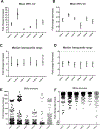How consistent are we? Interlaboratory comparison study in fathead minnows using the model estrogen 17α-ethinylestradiol to develop recommendations for environmental transcriptomics
- PMID: 28316117
- PMCID: PMC6145073
- DOI: 10.1002/etc.3799
How consistent are we? Interlaboratory comparison study in fathead minnows using the model estrogen 17α-ethinylestradiol to develop recommendations for environmental transcriptomics
Abstract
Fundamental questions remain about the application of omics in environmental risk assessments, such as the consistency of data across laboratories. The objective of the present study was to determine the congruence of transcript data across 6 independent laboratories. Male fathead minnows were exposed to a measured concentration of 15.8 ng/L 17α-ethinylestradiol (EE2) for 96 h. Livers were divided equally and sent to the participating laboratories for transcriptomic analysis using the same fathead minnow microarray. Each laboratory was free to apply bioinformatics pipelines of its choice. There were 12 491 transcripts that were identified by one or more of the laboratories as responsive to EE2. Of these, 587 transcripts (4.7%) were detected by all laboratories. Mean overlap for differentially expressed genes among laboratories was approximately 50%, which improved to approximately 59.0% using a standardized analysis pipeline. The dynamic range of fold change estimates was variable between laboratories, but ranking transcripts by their relative fold difference resulted in a positive relationship for comparisons between any 2 laboratories (mean R2 > 0.9, p < 0.001). Ten estrogen-responsive genes encompassing a fold change range from dramatic (>20-fold; e.g., vitellogenin) to subtle (∼2-fold; i.e., block of proliferation 1) were identified as differentially expressed, suggesting that laboratories can consistently identify transcripts that are known a priori to be perturbed by a chemical stressor. Thus, attention should turn toward identifying core transcriptional networks using focused arrays for specific chemicals. In addition, agreed-on bioinformatics pipelines and the ranking of genes based on fold change (as opposed to p value) should be considered in environmental risk assessment. These recommendations are expected to improve comparisons across laboratories and advance the use of omics in regulations. Environ Toxicol Chem 2017;36:2593-2601. © 2017 SETAC.
Keywords: Endocrine disruptor; Estrogenic compound; Interlaboratory comparison; Risk assessment; Transcriptomics.
© 2017 SETAC.
Figures



References
-
- McMaster ME, Jardine JJ, Ankley GT, Benson WH, Greeley MS, Gross TS, Guillette LJ, MacLatchy DL, Orlando EF, Van Der Kraak GJ. 2001. An interlaboratory study on the use of steroid hormones in examining endocrine disruption. Environ Toxicol Chem 20:2081–2087. - PubMed
-
- Feswick A, Ankley GT, Denslow N, Ellestad LE, Fuzzen M, Jensen KM, Kroll K, Lister A, MacLatchy DL, McMaster ME, Orlando EF, Servos MR, Tetreault GR, Van Den Heuvel MR, Munkittrick KR. 2014An inter‐laboratory study on the variability in measured concentrations of 17beta‐estradiol, testosterone, and 11‐ketotestosterone in white sucker: Implications and recommendations. Environ Toxicol Chem 33:847–857. - PubMed
-
- Munkittrick K, van den Heuvel MR, Metner D, Lockhart W, Stegeman J. 1993. Interlaboratory comparison and optimization of hepatic microsomal ethoxyresorufin O‐deethylase activity in white sucker (Catostomus commersoni) exposed to bleached kraft pulp mill effluent. Environ Toxicol Chem 12:1273–1282.
-
- Van Den Heuvel MR, Dixon DG, Munkittrick KR, Stegeman JJ. 1995. Second‐round interlaboratory comparison of hepatic ethoxyresorufin‐O‐deethylase activity in white sucker (Catostomus commersoni) exposed to bleached‐kraft pulp mill effluent. Environ Toxicol Chem 14:1513–1520.
-
- US Environmental Protection Agency. 2003. Comparative evaluation of vitellogenin methods 68‐W‐ 01–023. Washington, DC.
MeSH terms
Substances
Grants and funding
LinkOut - more resources
Full Text Sources
Other Literature Sources
Molecular Biology Databases
Research Materials
Miscellaneous

